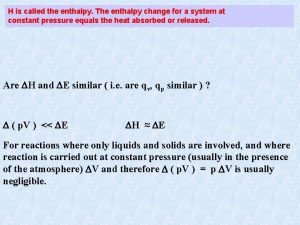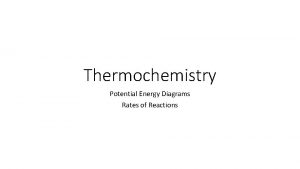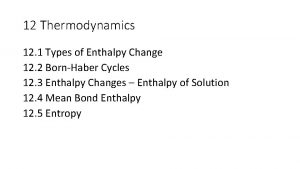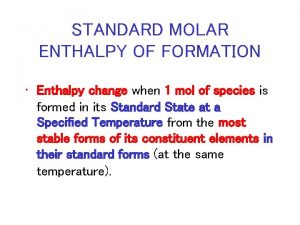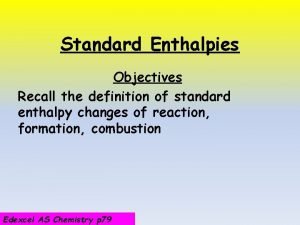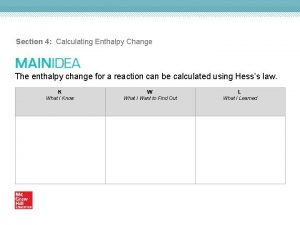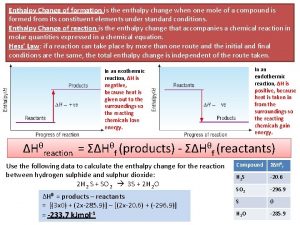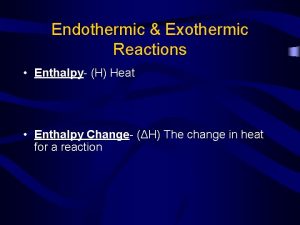H is called the enthalpy The enthalpy change












- Slides: 12

H is called the enthalpy. The enthalpy change for a system at constant pressure equals the heat absorbed or released. Are H and E similar ( i. e. are qv, qp similar ) ? ( p. V ) << E H ≈ E For reactions where only liquids and solids are involved, and where reaction is carried out at constant pressure (usually in the presence of the atmosphere) V and therefore ( p. V ) = p V is usually negligible.

N 2 + O 2 2 NO n = 0 ( p. V ) = 0 at const T, H= E N 2 + 3 H 2 2 NH 3 n = -2 (p. V) = -2 RT H = E + n. RT for reactions of ideal gases H = 2 Hfo ( NH 3 ) = 2 ( -46, 110 ) = -92, 220 joules

Example : Convert 1 mole of liquid H 2 O at 100 o C into 1 mole of H 2 O vapor at 100 o. C and p = 1 atm. H = 44, 013. 6 joules/mole What is E? H = E + ( p. V ) = E + p V (const p) 1 mole H 2 O = 18 gm; volume 1 gm of H 2 O at 100 o. C is 1. 04 m. L/gm vi = 18 ( 1. 04 ) = 18. 72 m. L vf = n. RT / p assume ideal gas

v = 30, 586 - 19 = 30, 567 m. L = 30. 57 liters. 082 L-atm = 8. 314 joules 101. 4 joules/L-atm E = H - p V E = 44013. 6 joules/mole - 3099. 5 joules/mole

General Definitions of heat capacities (for 1 mole of gas): (sub P means take derivative at constant P) (sub V means take derivative at constant V) Substitute d. Q = d. E + pd. V= d. E - dw (1 st Law) Remember (1 mole gas) = (3/2)R + R = (5/2)R

Bonus * Bonus * Bonus

Thermochemistry: Can measure H directly by making a laboratory determination of qp. Want to set up a table of enthalpy changes for chemical reactions Standard Enthalpy Change H for a system Standard State of a Substance That form of the substance which K is most stable at a pressure of 1 atm and T = 298�

Examples Carbon : at 1 atm, 25 C, Stand. St. is graphite (not diamond or coal) Bromine : 1 atm, 25 C Std. St. is liquid Bromine For a reaction: C ( graphite ) + O 2 ( g ) CO 2 ( g ) measure qp in lab (Heat released when burn graphite at const p) This means evolve 393. 52 kjoules of heat in converting 1 mole C graphite, 1 mole O 2 gas, into 1 mole CO 2 gas at 1 atm and 298 K. Can also burn CO in lab to produce CO 2:

Hess' Law of Constant Heat Summation Heat evolved or absorbed at constant pressure for any chemical change is the same regardless of the path by which the change occurs.

C (graphite) + O 2 (g) CO (g) + (1/2) O 2 (g) Can’t measure in the lab. (Always get a little CO 2)

Enthalpy's of Formation Standard Enthalpy of formation is ∆H for a reaction where a pure compound is formed from its elements with all substances in their standard states ( 25 C ) H 2 (g) + 1/2 O 2 (g) = H 2 O(l) ∆Hf ( H 2 O ) = -285. 8 kjoules Enthalpy of formation of elements in their standard state is defined to be zero: Why are ∆Hf useful?

Suppose we want to know ∆H for the reaction: 1 2 CH 3 COOH = 2 C (s) + 2 H 2 (g) + O 2 (g) = CH 4 (g) + CO 2 2 : ∆H = + ∆Hf ( CH 4 ) + ∆Hf ( CO 2 ) because ∆H is independent of path. In principle can always accomplish a chemical transformation by following a path which 1 st decomposes reactants into elements then reforms product.
 Enthalpy change equation a level
Enthalpy change equation a level Unit of enthalpy change
Unit of enthalpy change What is the overall enthalpy change dhrxn for the system?
What is the overall enthalpy change dhrxn for the system? Calculating enthalpy change
Calculating enthalpy change Communicating enthalpy changes
Communicating enthalpy changes Enthalpy change in a potential energy diagram
Enthalpy change in a potential energy diagram Calculation of enthalpy
Calculation of enthalpy Enthalpy of atomisation
Enthalpy of atomisation Molar enthalpy of formation
Molar enthalpy of formation Enthalpy change of reaction
Enthalpy change of reaction Enthalpy and calorimetry
Enthalpy and calorimetry Standard enthalpy of reaction
Standard enthalpy of reaction A relatively permanent change of behavior is called
A relatively permanent change of behavior is called


